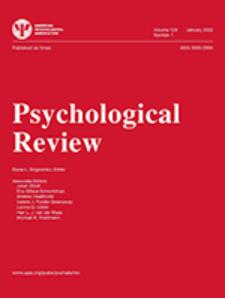形成数表示的选择性抽样说明。
IF 5.8
1区 心理学
Q1 PSYCHOLOGY
引用次数: 0
摘要
数量判断的两个主要模型将数字表示描述为心理数轴上的高斯分布。线性模型假设分布的均值和标准差都随着数量的增加而线性增加,而对数模型假设均值呈对数增长,具有恒定的可变性。在本研究中,我们使用选择性抽样帐户,该帐户提出根据目标和可用资源选择性地收集信息,以探索变异性和尺度变化背后的认知过程。在蓝色和黄色点的混合显示(蓝/黄任务)中,参与者依赖于位于中心附近的点的不完整表示,那里的空间分辨率最高,导致设置大小的变异性增加。相比之下,空间分离的显示(左/右任务)促进了更全面的采样,导致跨设置大小的近似恒定变化。行为模式和建模分析表明,所使用的尺度类型也受显示格式的影响,在混合显示中,更敏感的线性尺度用于计算数值差异,而在空间分离的显示中,较不敏感的对数尺度用于估计每边的大小。眼动追踪数据为我们的解释提供了进一步的支持,强调了选择性注意在形成数字表征中的作用,并为理解任务间的可变性和缩放提供了统一的框架。(PsycInfo Database Record (c) 2025 APA,版权所有)。本文章由计算机程序翻译,如有差异,请以英文原文为准。
A selective sampling account of forming numerosity representations.
Two leading models of numerosity judgments describe numerical representations as Gaussian distributions on a mental number line. The linear model posits that both the mean and standard deviation of the distributions increase linearly with number, while the logarithmic model assumes logarithmic increases in the mean with constant variability. In this study, we use the selective sampling account, which proposes that information is gathered selectively based on goals and available resources, to explore the cognitive processes underlying variations in variability and scaling. In intermingled displays of blue and yellow dots (blue/yellow task), participants relied on incomplete representations of dots positioned near the center, where spatial resolution is highest, leading to increasing variability with set size. In contrast, spatially separated displays (left/right task) facilitated more comprehensive sampling, resulting in approximately constant variability across set sizes. Behavioral patterns and modeling analyses suggest that the type of scale used is also shaped by the display format, with a more sensitive linear scale applied to compute numerical differences in intermingled displays, and a less sensitive logarithmic scale used to estimate magnitudes for each side in spatially separated displays. Eye-tracking data provide further support for our account, emphasizing the role of selective attention in forming numerical representations and providing a unified framework for understanding variability and scaling across tasks. (PsycInfo Database Record (c) 2025 APA, all rights reserved).
求助全文
通过发布文献求助,成功后即可免费获取论文全文。
去求助
来源期刊

Psychological review
医学-心理学
CiteScore
9.70
自引率
5.60%
发文量
97
期刊介绍:
Psychological Review publishes articles that make important theoretical contributions to any area of scientific psychology, including systematic evaluation of alternative theories.
 求助内容:
求助内容: 应助结果提醒方式:
应助结果提醒方式:


